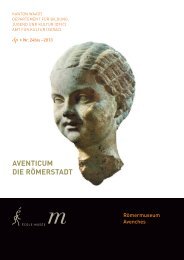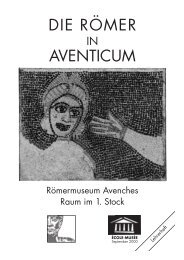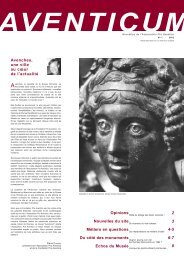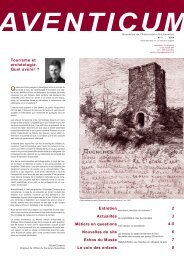Avenches – Roman Museum – Permanent Exhibition
Avenches – Roman Museum – Permanent Exhibition
Avenches – Roman Museum – Permanent Exhibition
Create successful ePaper yourself
Turn your PDF publications into a flip-book with our unique Google optimized e-Paper software.
Ground Floor The Inscriptions<br />
portraits of a private person found to date in Switzerland.<br />
Limestone. Funerary statue situated left of the middle statue in the aedicule of the<br />
southern En Chaplix monument. Around AD 40.<br />
14. Head of Attis<br />
Attis, the Phrygian god of vegetation and lover of Cybele, a goddess from Asia Minor, is<br />
represented here in a pensive and sad mood. His usual attributes are the Phrygian cap<br />
and Barbarian dress. In a funerary context he symbolises mourning caused by death<br />
and the anticipation of resurrection. This statue and its counterpart, of which only a few<br />
fragments were found, stood in the funerary garden.<br />
Limestone. Statue belonging to the southern En Chaplix monument. Around AD 40.<br />
15. Dancing Attis and Edge of a Clipeus (1)<br />
The limestone block shows a relief depicting Attis as a dancer with his left arm in the air<br />
and his right arm posed on his hip. He is wearing a Phrygian cap and Barbarian dress<br />
consisting of a long-sleeved tunic held together by a double belt and trousers plus a coat.<br />
The inside of the clipeus (round decorative motif) on the adjacent block (not preserved)<br />
was decorated either with a floral motif or with a mask.<br />
The presence of such a motif and the image of the dancing Attis, which appeared<br />
from the 3rd century BC onwards, clearly show the influence from southern Gaul.<br />
The clipeus motifs are widespread along the River Rhone. While, on the other hand,<br />
representations of a dancing Attis are frequently found in Provence, they are not known<br />
in the provinces along the Rivers Rhine and Danube.<br />
In the Cybele cult Attis dies every winter to be reborn in spring and in the funerary<br />
context he is a symbol for death followed by resurrection.<br />
The reliefs with Attis and the clipeus were situated in the corners near the base,<br />
probably framing the lost inscription.<br />
Limestone. Relief from the lower corner of the podium of the southern En Chaplix<br />
monument. Around AD 40.<br />
16. Nereid Riding on a Sea Griffin (2)<br />
A Nereid with her coat blowing in the wind is sitting on a bearded sea griffin and holding<br />
a shell in her hand. Nereids often ride on sea griffins with eagle or lion heads. The latter<br />
belong to the thiasus (retinue) of sea deities. Like in the case of the group of Triton and<br />
Nereids, models for <strong>Roman</strong> representations can be found in the Hellenistic period (3rd <strong>–</strong><br />
2nd centuries BC). These groups symbolise blissful life after death.<br />
Limestone. Group placed in the upper right-hand corner of the façade of the southern En<br />
Chaplix monument. Around AD 40.<br />
The Inscriptions<br />
Among other sources, written messages have always been the most important<br />
evidence on which to base our interpretation of the past.<br />
Today, several hundred thousand inscriptions from all provinces of the <strong>Roman</strong><br />
Empire are known; they are preserved on various types of materials. The texts were<br />
carved in stone or put together as mosaics, engraved on metal objects, stamped<br />
or scratched onto pottery or tiles, written in ink on papyrus sheets or simply<br />
1<br />
2<br />
16<br />
Ground Floor








